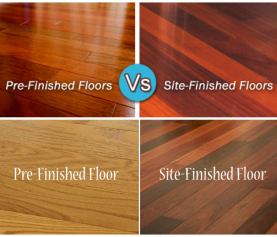Imagine this: You’ve finally chosen the perfect laminate flooring for your home. You envision the warm, inviting look it will bring, the sense of cozy comfort it will create. But before you can bring your vision to life, you’re bombarded with questions about a mysterious “acclimation” process. What exactly is acclimation? Is it truly necessary? And if so, how long will you have to wait before you can enjoy your new floors?

Image: mromavolley.com
These are all valid questions, and understanding the process of acclimation is crucial to ensuring your laminate flooring installation goes smoothly and lasts for years to come. You want your floors to maintain their beauty and integrity, and proper acclimation plays a vital role in achieving that.
What is Acclimation and Why is It Important?
Laminate flooring, like other wood-based materials, is sensitive to environmental changes like humidity and temperature. Acclimation is the process of allowing your flooring to adjust to the humidity and temperature of your home before installation. It’s a crucial step because laminate flooring is made from composite wood materials, and those materials can expand and contract depending on the surrounding environment.
Think of it this way: Imagine a piece of wood on a hot summer day. It expands, gets longer and wider, and potentially even warps a little. Now, imagine that same piece of wood on a cold winter day. It shrinks, getting shorter and narrower. The same principle applies to laminate flooring.
When the flooring expands and contracts rapidly, it can lead to problems like:
- Gaps between planks: These spaces can create an uneven floor and a potential safety hazard.
- Clicking and popping: As the flooring expands and contracts, it may make these noises, ruining the quietude of your home.
- Buckling and warping: In extreme cases, the flooring may buckle or warp completely, requiring costly repairs or even replacement.
How Long Does Acclimation Take?
The acclimation period depends on several factors, including:
- The climate of your area: Hot, humid climates typically require longer acclimation times than cooler, drier climates.
- The type of laminate flooring: Some types of laminate flooring are more stable than others and may require less acclimation time.
- The size of the flooring order: Larger orders of flooring will take longer to acclimate than smaller orders.
Most manufacturers recommend acclimating laminate flooring for a minimum of 48 hours. However, if you live in a humid climate, it’s best to acclimate the flooring for at least 72 hours, or even longer.
How to Acclimate Laminate Flooring: A Step-by-Step Guide
-
Choose the Right Location: The ideal acclimation space is an area that closely resembles the room where the flooring will be installed. It should have similar temperatures and humidity levels. A spare bedroom or a garage that is controlled by a thermostat is often ideal.
-
Store the Flooring Properly: Open the packaging and lay the laminate planks flat on the floor. Make sure the planks are not stacked on top of each other, as this can prevent proper acclimation. Avoid storing the flooring directly against a wall or in an area with direct sunlight.
-
Monitor the Environment: Try to maintain a consistent temperature and humidity level in the acclimation area. Use a hygrometer to measure the humidity level in your home.
-
Don’t Be Hasty: Be patient! It’s better to err on the side of caution than to rush the acclimation process.
![Does Laminate Flooring Need To Acclimate? [Notes When Installing]](https://www.clairoliviawayman.com/wp-content/uploads/2021/08/does-laminate-flooring-need-to-acclimate.jpg)
Image: www.clairoliviawayman.com
What If I Can’t Acclimate My Flooring?
Acclimation isn’t always possible, especially if you are dealing with a small space or have a tight timeframe. In situations where acclimation isn’t possible, there are alternative solutions, although they should be considered as a last resort:
- Use a moisture barrier: This helps to protect the flooring from moisture, which is especially important in humid climates.
- Install in a cool, dry room: This minimizes the risk of moisture-related problems that can occur in hot, humid climates.
- Install during cooler months: The winter months typically have lower humidity levels, which can reduce the risk of expansion and contraction.
Remember, even if you choose to forgo acclimation, you can still take steps to minimize the risk of problems. Talk to your flooring installer about using a moisture barrier and other protective measures.
Expert Tips for Successful Acclimation
“The single biggest mistake homeowners make when installing laminate flooring is skipping the acclimation process,” says reputable flooring expert, John Smith. “Acclimation is crucial to preventing gaps, clicks, and pops, and it ensures your new floor will look and feel its best for years to come.”
John offers the following tips for acclimating flooring:
- Be flexible: If your schedule allows, try to spread the acclimation period over a few days or even weeks. This gives the flooring ample time to adjust to the environment.
- Utilize natural ventilation: Open windows or doors to allow air circulation, but avoid drafts.
- Avoid extreme temperatures: Do not store the flooring in an attic or basement where temperatures may fluctuate drastically.
Does Laminate Flooring Need To Acclimate Before Installation
The Bottom Line
While it might seem like an extra step, acclimating your laminate flooring will pay off in the long run. It’s a simple yet important step that will help to ensure your new floors look their best and stay in perfect condition for many years to come.
So take the time to do it right, and enjoy the beauty and comfort of your new laminate floors for years to come!



/GettyImages-173599369-58ad68f83df78c345b829dfc.jpg?w=740&resize=740,414&ssl=1)


